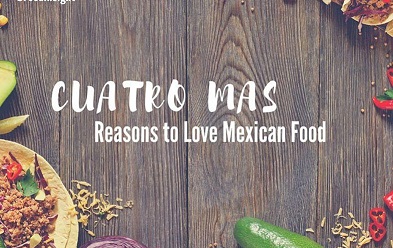Your Location:Home - Hot Topics > - Content
News and Information
Cuatro Más Reasons to Love Mexican Food
Time:2016-05-06 14:54:09
Source:Food Insight

1) Queso (cheese) is packed with calcium and vitamin D.
When I think of queso, the Mexican word for cheese, I imagine ooey, gooey, bright yellow, melty cheese, used as a dip for my tortilla chips or fresh vegetables. But queso is so much more than that. Mexican cheeses range in variety just as much as the cheeses you usually find in your local grocery store.
Soft Cheeses: Queso Blanco and Queso Fresco are similar to mozzarella and Monterey Jack cheese. These cheeses will not melt when heated.
Melty Cheeses: Manchego and Oaxaca that are perfect for topping nachos or stuffing in burritos.
Hard Cheeses: Cotija and Enchilado can be grated and sprinkled on top of beans, salads or meats.
No matter which cheese you pick or how you eat it, they are rich in calcium and vitamin D.
Calcium is a nutrient necessary for muscle and bone health. Vitamin D helps your body absorb calcium, in turn aiding in bone and dental health. Deficiency of calcium and vitamin D in your diet can result in osteoporosis, a condition defined by bone weakness and loss. Cheese is also an excellent source of protein, with about 7 grams of protein in one ounce. Protein is necessary for maintaining muscle mass and strengthening muscles. Because cheeses can be higher in saturated fat, just remember that a little goes a long way.
2) Cilantro is chock-full of vitamins.
Cilantro is the bright green leaves of the coriander plant. It is used all over the world as an herb to add its citrus-like taste and a pop of beautiful green. In Mexican cuisine, cilantro is used as a garnish and flavoring in salsas and guacamoles. Cilantro is rich in vitamins A, C, and K. Vitamin A improves immune function and may promote eye health. Vitamin C may promote immune strength, prevent infection and slow aging. While research is still determining vitamin K’s role in bone health, it appears that insufficient levels of vitamin K can have negative effects on bone density, resulting in fractures. If you have not noticed, these little green leaves pack a big punch!
3) Chili peppers may help with digestion.
Chili peppers are the berries of the capsicum plant. There are more than 150 species of chili peppers, varying in color, size, shape, flavor and heat level. Some types of chili peppers include poblano, jalapeño, habanero, Anaheim, cayenne and bell. They have been used for thousands of years for culinary and medicinal purposes.
Chili peppers are used all across the world. In Mexican cuisine, chili peppers are incorporated to impart added flavor and sometimes spice to dishes. Poblano peppers are stuffed and baked to make a classic dish called chili rellenos. Chipotle peppers are jalapeno peppers that have been dried, and they add a smoky flavor to sauces. Habanero peppers are one of the hottest chili peppers and add heat to salsa. The powdered form of red peppers, cayenne pepper, is also a seasoning that is used in many dishes. Capsicum is used for digestive problems like upset stomach and intestinal gas, heart and vessels conditions, and even on skin to relieve muscle pain and spasms.
4) Corn (maize) is full of fiber.
Maize, coming from the Spanish word maíz, was originally domesticated by indigenous people in Mexico more than 10,000 years ago. It is commonly called corn and is in the forefront of Mexican cuisine. Corn is used whole in salsas, as a topping, eaten straight off the cob or ground into cornmeal to make tortillas, tortilla chips, tamales, pozole, and other dishes. Not only is corn a versatile addition to your Cinco de Mayo feast, but it is also a vegetable rich in fiber that helps promote digestion. It is a great source of carotenoids, which gives it that bright yellow color and promotes eye health and decreases the risk of some cancers.
Try adding these Mexican ingredients to your Cinco de Mayo celebration. With vitamins, fiber and mouthwatering flavor, they are sure to add taste and nutrients to your meal. So get ready for a Cinco de Mayo feast packed with Mexican flavors and nutrient-rich ingredients!



